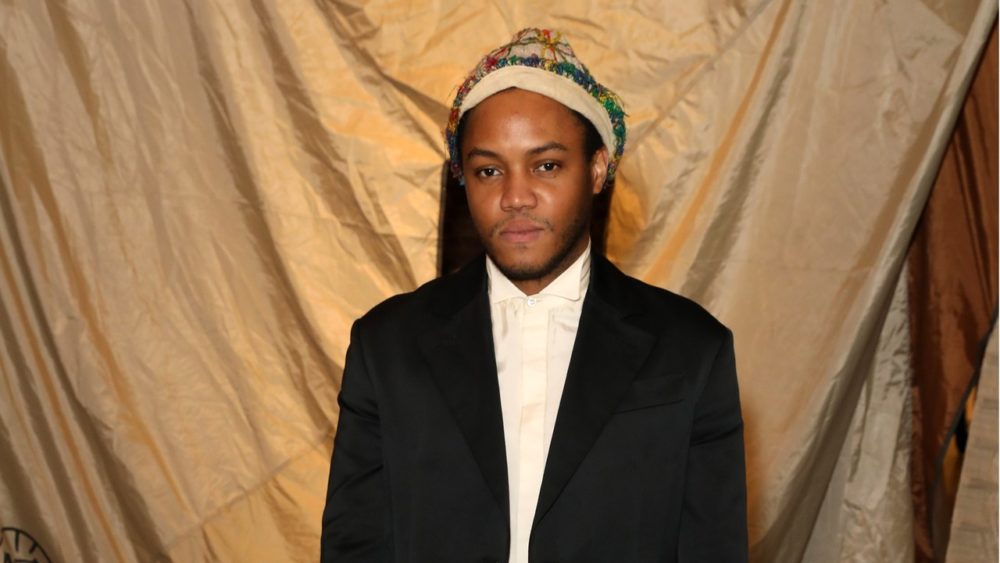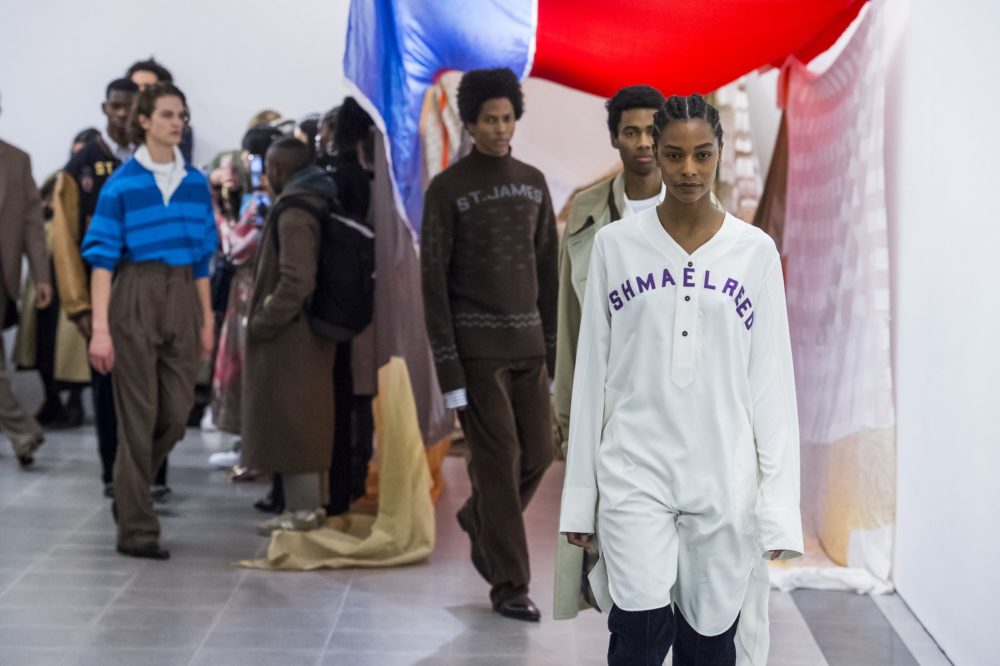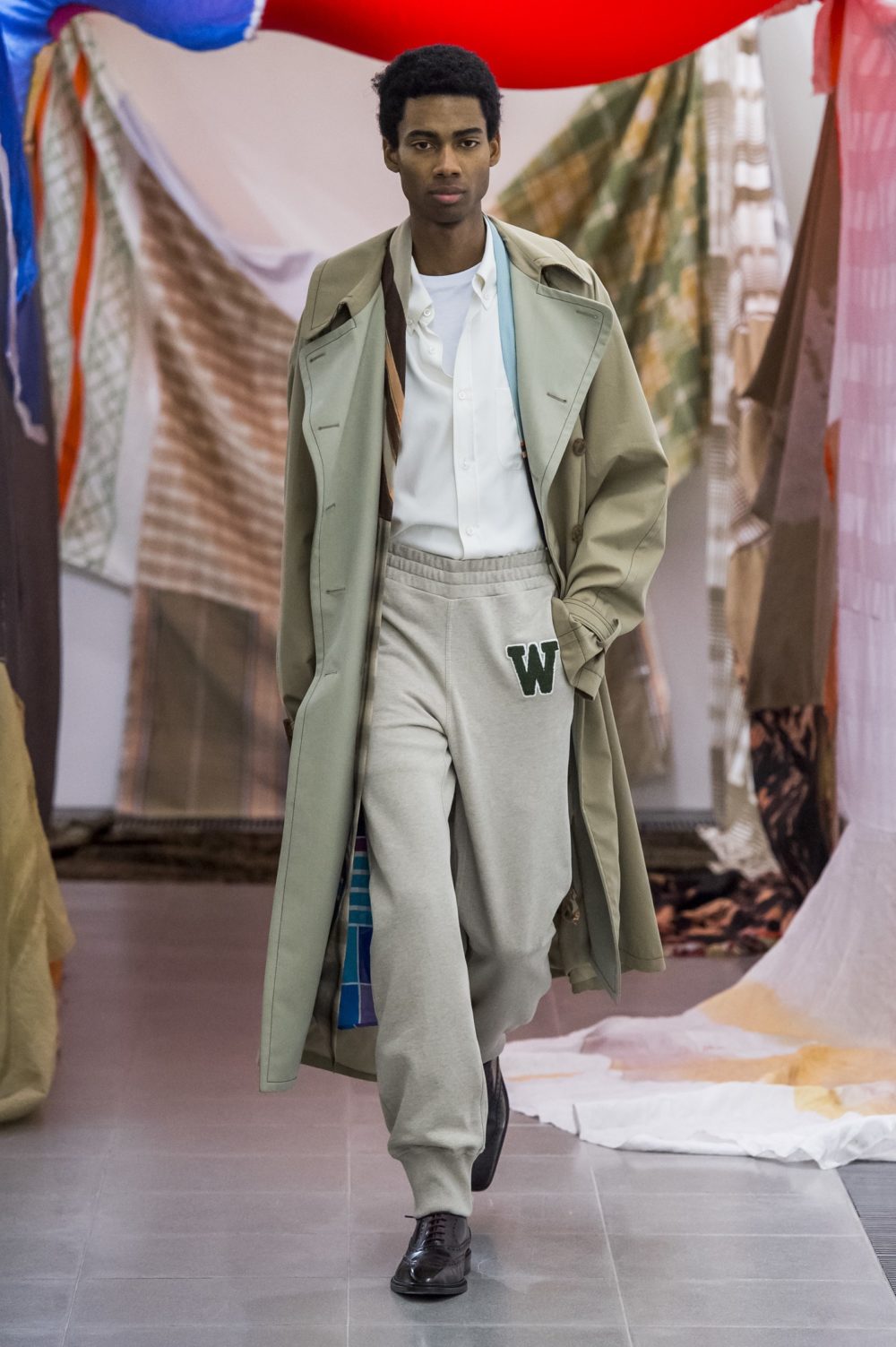
- Source: GQ
- Author: RACHEL TASHJIAN
- Date: March 20, 2019
- Format: DIGITAL
Eric N. Mack Is Bringing Lil Kim Fashion Energy to Art
Between his work for Grace Wales Bonner and the Whitney Biennial, artist Eric N. Mack is having a very dope year.

Photograph courtesy of Getty Images
In an unusually fun season of Fall/Winter 2019 men’s fashion shows, Grace Wales Bonner’s London show was one of the most powerful. Against a backdrop of muted plaid and gingham textiles, Wales Bonner’s combinations—sweatpants with brown brogue shoes; an oversized dinner jackets with jeans, accessorized with talismans and rastacaps—exuded calm and elegance.
That show, and those backdrops in particular, were also the latest chapter in an ongoing collaboration between Wales Bonner and the New York artist Eric N. Mack. Like Wales Bonner, Mack’s work has been bubbling intensely for the past few years, and is now suddenly everywhere, with new urgency. In January, a solo exhibition of his work, Lemme Walk Across the Room, opened at the Brooklyn Museum; a few days later, a group exhibition curated by Wales Bonner, A Time for New Dreams, which included Mack’s work, opened at the Serpentine in London. A few weeks later, he debuted a work made from fabric donated by Missoni draped on an abandoned gas station at California’s outdoor biennial, Desert X (tragically, the work burnt down under mysterious circumstances earlier this month). A few days before we met, in late February, he was announced as participating artist in the Whitney Biennial, the longest-running survey of contemporary art in America.
Mack’s work is an unusual new proposition in the long-running relationship between art and fashion. Sure, there’s the surface-level engagement with the industry—Mack makes paintings from textiles and sculpture from button-down shirts. But his work is concerned with the nuances of fashion that are more difficult to describe, too: its gestural affectations, its ephemeral nature, its obsession with “the moment,” and its tendency towards amnesia (today you’re in, and the next you’re out, as they say). The centerpiece of his Brooklyn Museum show, titled “The opposite of the pedestal is the grave,” is a sculptural assemblage of a ladder, chicken wire, mop, and bedskirt whose sashaying shape recalls the moment a model spins around on the runway—or more broadly, embodies the less permanent instant when we nail a look. (You might say it’s the visual representation of the moment when you’re “getting a fit off.”) “Seat Pleasant,” dyed cotton expanses of fabric strung on ropes, are paintings that, like fashion, are at their best when moving. An electric fan blows the curtains, like the work is taking orders from a high-powered photographer. Like Wales Bonner’s work, it radiates gorgeous calm, but it’s also stylish and full of attitude.
Mack and I spoke about his work with Wales Bonner, his love for Lil Kim, and his plans for the Biennial.

Wales Bonner, Mumbo Jumbo AW19
A lot of artists work, or are “in conversation,” with fashion, but it’s much more about textiles and the visual forms of clothing, or it’s about criticizing consumer culture or the fashion industry’s malpractices. How do you think of your relationship between fashion and art?
I think that there’s certain kinds of weight that we don’t give to that language—for example, I dropped my clothes off at the laundromat today, and I talked to the woman there about what I needed done to them. There is a certain kind of universality, of domestic language, that is really the basis of fashion. The basis of garment culture is reading price tags or fabric tags. I don’t ever want to lose that intimacy, but I want to acknowledge this production that happens at the same time as so-called art world production. We exist in a time where there’s so much crossover, so much overlap [between art and fashion], that I really want to test out how we define these things at this point in time.
Like the fashion industry and music industry exist as one, and that’s been true for a really long time now. And it’s not really like, parsed through—you don’t really see musicians these days that you would say have bad style. It’s just seamless.
What attracted you to fashion in the first place, as a young person and as a part of your art?
I loved and hated the amnesia. I was obsessed with the amnesia. And the fact that I couldn’t forget.
Do you mean the history of fashion, or who’s left out of fashion, or something else?
All of those things, actually. An obsession with the past, an obsession with the future, what could be, or a revisiting. Like when [fashion critic] Tim Blanks [says something like]: “a return to female sensuality on the runway!” I love that. The return. But the forgetfulness is a harder thing because it’s political.
And the idea that what’s last season is wrong, and bad, and outmoded, or old. Passe. Faux pas. Those are things that exist in the art world, as well.
Were you looking at magazines and runway images, or celebrities who were bringing something individual to fashion?
It’s not even a real “covet” situation where I feel like I have to buy it. I remember when Balenciaga was right on 21st Street, where you went to see the gallery shows. So after I went to see some gallery shows, I thought, I’ll just walk into Balenciaga. This was 2008, maybe 2009. I was looking for the Spring/Summer collection, and I just remember them telling me, we don’t have that anymore. I went there to examine it. To look at it. To touch it. I was like, I’m seeing all this art, and this is [then-creative director] Nicolas Ghesquiere’s—it felt so significant. It felt like something alien that I needed real proof of. So there was that moment of loss. And they gave me all these lookbooks, and I was like, Sure! I’ll take these!
But there’s still this desire for that: to feel those moments, and not necessarily inhabit them, but create them for a more accessible consumption, acknowledging them for what they do, rather than what they are.

Wales Bonner, Mumbo Jumbo AW19
But you also get that sense of the “covet” situation. Like the fabrics for Grace’s show, or the pieces in the Brooklyn Museum show—it’s not even like you want to touch them, but more like you want to put them on the way that you see a crazy Givenchy jacket and want to put that on, because you wonder what it feels like.
I attribute that to a certain kind of poetry. I think there’s poetry that will allow for that to be imagined, and I think of fashion magazines as an extension of literature in that way.
A lot of [my work] has just been like, getting to the clothes. Getting to the clothes, getting to the space of a kind of beauty, excess, and a picture. And not being afraid of that picture just because it was clearly representational, it was clearly tied to a different kind of manifesto, where it had different meaning attached to it.
What is it that you love about Lil Kim?
You can understand certain things: she’s a woman in control, sex positive, that loved beautiful things. And that was attributed to her meaning—her wearing beautiful things meant she was beautiful. And not only in this literal way, but that she felt good in it, she felt sexy in it. And that was a part of what she spoke about, what she rapped about—that she was talking about pleasure, and it was basically like, “And the rich women know exactly what the fuck i’m talking about.” And because she was rich—in what ever way she wanted to be rich, but she also had Chanel.
Now it’s becoming more clear to me, especially in light of these Italian fashion brands, Prada and Gucci specifically, having these blackface scandals, which ends up communicating to black people, African-Americans specifically, that the clothes weren’t made for them, that they are not being considered as everyday wearers. For her to be styled in Versace, she ended up being very significant.
Then there’s her own appropriation and use—you know, putting poetry into those clothes. There is this insane video that she did for Yo MTV Raps! that I can’t get out of my mind, where she’s at Bergdorf’s and she’s just so excited. It’s great. It’s amazing. There’s a real enthusiasm, almost a fearlessness—taking these things and being able to give meaning to them through her wearing them.

Wales Bonner, Mumbo Jumbo AW19
So how did you meet Grace?
I met her at the opening of an exhibition that we were both included in, at the Camden Arts Center, that was curated by Duro Olowu. From then, we started discussing what it would mean for us to work together.
How did you conceptualize that?
She always shares with me the moodboard, and the clothes as they develop. What she’s reading, music she’s interested in.
From there, I think about fabrics that would be adjacent to the conversation that the garments would be having in the collection. I’ve used a lot of silk organza in general, but [in the Spring 2019 collection], for example, we talked about the space between a flag and a sail…. The fact is that it has to sit behind every image on the runway, so there was this intervention that was about to take place [during the show]. It’s still very central to my language, but it’s really generous, and it’s exciting but strange.
You also had some pieces in the show, as well, right?
I made collages that were turned into garments. The kimonos, and then there were finishes on several of the coats and jackets that were from scarves, silk scarves, and finishes and trimmings and things like that that I collaged together.
It seems that your work and Grace’s share a lot of ideas about the instinctiveness of style and how that’s elevated into fashion.
These luxury brands, it’s been put together that they don’t have black people on staff, so therefore these things are produced without black consumers or black wearers in mind. Grace is designing for a black consumer. I think we both have this kind of vision that is about an everyday experience that is linked to, in communication with, black culture, and a conversation within black culture.
And obviously [there is] an acknowledgment of past omission, past amnesia. You look back and you see that Yves Saint Laurent did this amazing runway show in the early ’80s with mostly black models, and pantsuits—a collision between this transgression in gendered clothing, and representation, and this cultural overlay. This has happened before. These things happened before. But to really acknowledge that there are new authors that haven’t been included, and new kinds of authorship as well, that is on the world stage, with everybody watching.
What are you wearing now?
A Noah sweatshirt, and this sweater is vintage Missoni; I got it in Milan at a second-hand shop. The pants are Marni. I’m wearing a shirt by this amazing [English] designer Mowalola. The hat is vintage.
New York is hard. There are very few places that actually get vintage in the city-proper anymore. More recently, I’ve been thinking more about what luxury means, and really going to Prada.
I love that Prada store in Soho. The crazy Rem Koolhaas slide makes it less intimidating.
I love all these moments of discovery. Like going to the original Dover Street [Market] in London for the first time, and seeing the first Vetements trench coat in the women’s section, and trying it on and feeling like I’m wearing a bunch of fabric in a really fantastic way. You feel like you’re in this tradition; you’re just like a character. It’s nice to be able to go outside your normal sensibilities and play—use fashion.
How are you preparing for the Biennial?
I’m seeing myself as Miuccia Prada: “How do I feel right now?” And I’m going to produce [from there]. I’ll say that the work will be very fresh. And hopefully it will have its urgency. I’m super excited.
This interview has been edited and condensed for clarity.

